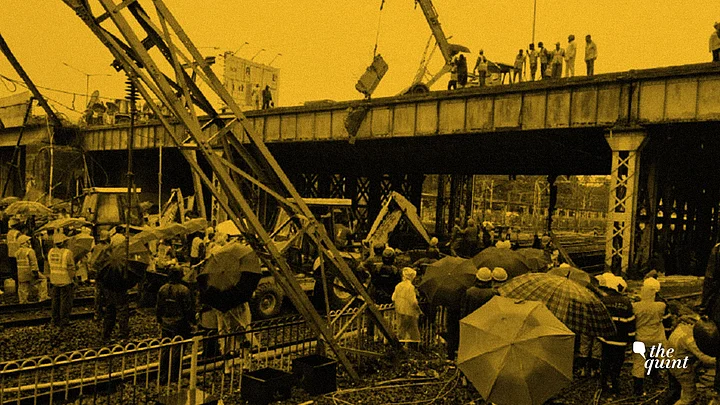(This article was first published on 3 July 2018 and is being republished in the aftermath of a CST overbridge collapse on 14 March 2019.)
Hard-headed as a mule, the Indian Railways never learns. On 29 September 2017, the New Elphinstone Bridge collapse in Mumbai killed 22. In spite of numerous bridge engineers, assistant bridge engineers and chief bridge engineers, Union Minister for Railways, Piyush Goel, roped in the Army to re-build the bridge – which they did in 117 days. A sensitive chief bridge engineer like the British tunnel engineer Mr Barog, would have at least resigned for this blatant lack of confidence. (Mr Barog failed in connecting a tunnel in the Shimla-Kalka line and was fined Re 1 by the Railways, and for that he committed suicide. The tunnel is named after him.)
But our railway engineers, shamelessly continued to bask in an environment where there is total lack of accountability. As a result, we have had to face another tragedy on 3 July 2018, when the Andheri Road over-bridge, built by the Indian Railways, collapsed.
Just because we got lucky and there were no casualties, the negligence does not become less gross or less criminal.
And the Divisional Railway Manager has not been suspended yet.
A Laid-back Indian Railways
This is not the first time such a tragedy has taken place. On 11 February 2013, at the Allahabad junction, a stampede killed 36 Kumbh Mela pilgrims. On 16 May 2010, a last- minute change in the platform caused panic, and a stampede at the New Delhi Railway station, resulting in two deaths. Pratap Rudy of BJP called the deaths “inexcusable and unpardonable” and blamed the then “absentee minister”.
When Railway men talk of railway safety, they usually speak of rails, coaches, level crossings and engines – and never about foot over-bridges and road over-bridges. FOBs and ROBs do not find a mention in the table of accidents.
Just two facts will illuminate the Railway bureaucrats’ attitude towards safety.
When the then Railway Minister created a Safety Fund of Rs 17,000 crores, admittedly, a chunk of it was spent on rolling stock, which should have come under Capital Expenditure.
The Parliamentary Standing Committee report on the action taken on its recommendations says (SCR 188 2013-14) that only less than 40 percent of the money allotted for safety had been utilised by the Railways in the preceding two years, and the balance was returned. Did the Railways spend all the money allotted, the next year? No. They made the money non-lapsable.
Unless drastic reforms are made and accountability are built into the system at all levels, the Railways will continue to lower its standards, killing thousands along the way. The first thing to be imbibed in the minds of the Railway officers is that the Railways are not only for those who work for it, but it is for the public who own, maintain and support the Railways.
Piyush Goyal Should Listen to Gurcharan Das
I was happy to find that what I have been saying all along, was very much in alignment with the thoughts of eminent writer, economist and member of NITI Aayog, namely, Mr Gurcharan Das.
According to Das, in the foreword to Indian Railways – The weaving of National Tapestry, “One sometimes fees that the purpose of Indian Railways is not to serve customers but to tend to the comforts of the 1.3 million employees who have jobs for life. Employees account for 50 percent (sic) (it is 53 percent) of the Railway costs in India. And reflect seven times more manpower per kilometer than in developed railway countries. Friends and families of Railway employees occupy, on average, 40 out of the total 100 berths in the two-tier (AC) sleeper class and get priority in bookings (sic).”
‘Metro Man’ E Sreedharan said in an interview to The Hindustan Times, “Bullet trains will cater only to the elite community. It is highly expensive and beyond the reach of ordinary people. What India needs is a modern, clean, safe and fast rail system.”
He added, “...I do not agree that the Indian Railways has made rapid progress. Apart from bio-toilets, there is no technical up-gradation. Speed has not increased. In fact, the average speed of most prestigious trains has come down. Punctuality is worst – officially 70 percent, actually less than 50 percent. Accident record has not improved. Many also die on tracks and at level-crossings in the suburban sections. Almost 20,000 lives are lost on tracks annually. I feel Indian Railways is 20 years behind those of advanced nations.”
Piyush Goel must listen to Gurchran Das and to E Sridharan, if not to freelance journalists like me.
Part of the solution is to re-structure the Railway Board, inducting professionals into it, making all the present member HoDs answerable to the Board, and merge 17 zones into 9, as it originally was, or 5 as it earlier used to be, making them corporations.
Change the accounting system and attract private investments and establish accountability at every level, and introduce technology to weed out corruption.
(The writer is Secretary, Consumer Protection Council, Tamil Nadu. This is an opinion piece and the views expressed above are the author’s own. The Quint neither endorses nor is responsible for the same.)
